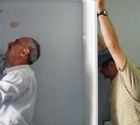
Avi & Sallie Tangir
To anyone with decades of experience in Europe of wine buying and enjoying, the idea of a home-produced wine by an amateur is one to cast out of the mind. Not these wines! Read on.
AVI TANGIR is a wine enthusiast. He spent forty years as a senior executive for Zim Lines including years in charge of the company's operations in Nigeria and Madrid. Now retired, he lives happily in Tel Mond with his wife, Sallie. Avi was born in Morocco, Sallie in England.
I visited him at his home in early July and was made most welcome. He vinifies one type of grape - Cabernet Sauvignon. That is the most traditional of red grapes for red wine. In the 2005 edition of Sotheby’s Wine Encyclopedia, it is described as: "A classic grape, perhaps the greatest red wine grape in the world."
Avi purchases his grapes from Ramat HaGolan vineyard which is 600 meters above sea level. He does so, he told me, because the ambient temperature and the ground temperature at that height are not as extreme from the hottest to the coolest parts of the day as at lower levels. So that there is maximum sun equally on all the vines, they have to be planted on a North/South axis. In Ramat HaGolan, a lot of the soil is porous. That allows the water to sink down to the roots more readily. Below 600 meters, humidity is affected and is greater. Above 600 meters, the humidity is less, which is better for the required lesser sugar content of the grapes.
He checks the percentage of sugar in the grapes with a special meter. To get maximum quality of grape, for any resulting wine, not more than 1.3 tonnes per dunam should be planted.
The grapes are crushed manually by Avi turning a handle on his crusher so that the grapes are squeezed and the juice is extracted from them. There is no mechanical interference.
According to Avi there are three essential elements in each grape:
- The flesh for the juice;
- The skin for color of the wine and some tannin;
- The pips for tannin.
He explains: "The crushing machine is delicate enough to cut the skin of the grapes - gently, not crush in fact, despite the name of the machine - but to open the skins and then there is a natural seeping out of the juices. The process of fermentation begins - with the oak barrels not more than two-thirds full. Every four hours, it is necessary to turn the skins by means of a plunger to push them down in order to get a better color. After about fourteen days primary fermentation is complete.
"There is a measuring to check the surface density of the wine which confirms that primary fermentation is finished. Then, it is necessary to wait a further two months for the required second stage of fermentation to finish.
"The acidity of the wine is checked throughout the foregoing process. At the end of fermentation, the wine is transferred into new oak barrels. These barrels have to be renewed every five to six years.”
The new oak barrels were purchased by Avi in Bulgaria on a special trip during which he was accompanied by a rabbi who verified the kashrut of the barrels. Avi will repeat this process when the barrels need to be renewed.
The wine stays in the barrels for twenty-four months to reach maturity.
Now, let us experience the matured wine by a tasting.
I was offered two wines. Remember that Avi's wines are from one grape type only - the Cabernet Sauvignon, so there will be a common denominator to all his wines. What will we discover from tasting two different ones he has produced?
The two wines I tasted were his 2006 Cabernet Sauvignon -13% alcohol by volume; and his 2006 Port-type wine - 18% alcohol by volume. Both are wines of a powerful nature. The normal alcohol strength of a traditional Portuguese Port wine is 20% by volume. The Cabernet Sauvignon was intensely dark in color in the glass and when held up to the light it was clear and fresh-looking, just as it should be. The palate was clean and it gave the mouth a full sensation of mint/blackcurrant taste. The fullness of the wine was all it should have been. The aftertaste was clean and it digested very comfortably. This is a wine that will be eminently drinkable on its own as a pleasurable experience, or with a well prepared meat meal. In that case, drinking it after the soup and with the main course is recommended. The wine will well accompany and enhance a strongly flavored beef or well roasted fowl dish, but not lamb, as it would bury the delicacy of the meat. Any left in the bottle after the main course should be preserved for a long enjoyment on its own later in the day, or even the next day, as this wine will even improve and develop its characteristics with a little open time. I recommend opening the bottle a good hour before consuming and if you have a decanter, decant it on opening in order to get the full development before drinking.
And now to Port. The characteristics of the Cabernet Sauvignon which I described above are replicated in the Port-style wine Avi produces - and intensified. This is a wine that needs time and relaxation in which to enjoy it, and in which to understand and appreciate it in full. It is a modern classic in the wine world, and not commercially produced or available. It should not be taken with food in my opinion; it should be imbibed, internalized literally on its own for its own sake. I enjoyed sipping it.
There is a lesson for us in this tale. It is that we - any of us - can make our own first class, delicious wine, given the time, the equipment, the patience - and the grapes!
L'chaim!
 A PLACE OF THEIR OWN
A PLACE OF THEIR OWN THANK YOU!
THANK YOU! DEAR EDITOR 156
DEAR EDITOR 156-1516356428.jpg) Hand in Hand Food Pantry
Hand in Hand Food Pantry Forever Slim
Forever Slim Food Foolish
Food Foolish